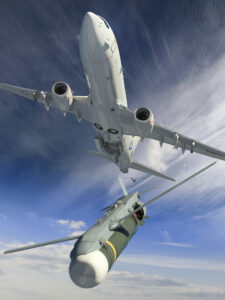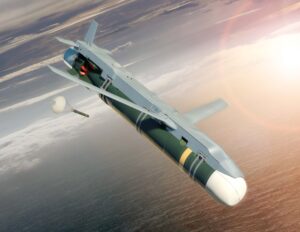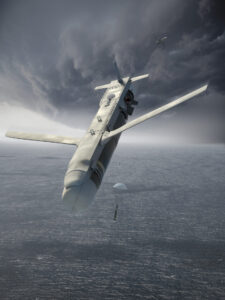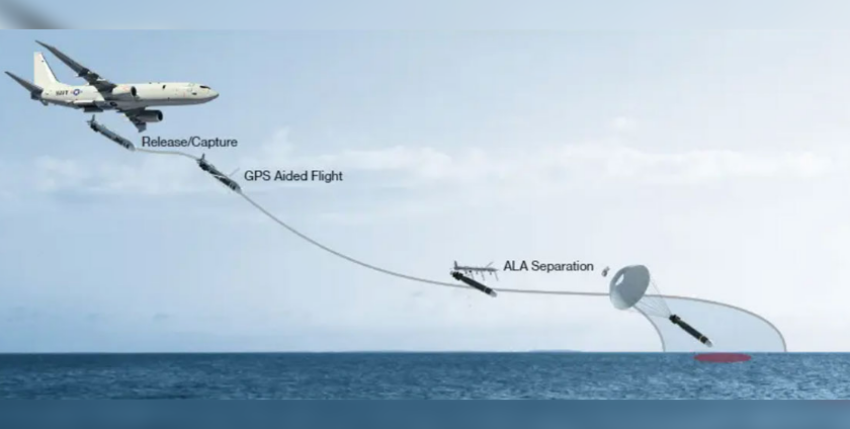The US Navy has placed an order with Boeing for the series production of the so-called High-Altitude Anti-Submarine Warfare Weapon Capability (HAAWC). This is a 'glide body', a so-called Air Launch Accessory (ALA) kit, which is attached to a Mk 54 U-Jagd torpedo. The folding wings spread out after the HAAWC is launched. The torpedo is guided to the target by an autopilot in the ALA using GPS data. Once it has dropped to an acceptable altitude, the ALA drops it at a point assigned by the mother aircraft's weapon deployment system, which is calculated based on the torpedo entry point.
The contract between the US Naval Sea Systems Command and Boeing has a total value of USD 25.6 million. The total value of the contract could increase to USD 121.4 million if all negotiated options, including an increased number of units, are honoured.
The HAAWC modules are scheduled to be delivered by September 2024. Further HAAWC modules could be delivered by September 2030 if an agreed expansion option is exercised.

New torpedo deployment options
With the help of the HAAWC, the U-Jagd torpedo can be deployed from high altitudes. This may be necessary for tactical-operational reasons - especially in a complex environment in which the aircraft is exposed to a threat as a weapon carrier and therefore operates at altitudes other than the usual (low) altitude bands. Freely accessible US publications state that the 'normal' launch altitudes of the torpedo in the US Navy are around 100 feet. According to industry information, the HAAWC enables "an altitude of up to 30,000 feet". In addition to the hazard reduction, the aircraft no longer has to leave its usual patrol altitude for the torpedo attack. This means that aerodynamic stresses and delays can be avoided. The torpedo becomes a precision gliding weapon.
Since the first half of the 2000s, the US Navy has been considering a 'stand-off' deployment of the sub-hunting torpedo from the aircraft. In summer 2006, Lockheed Martin published its "LongShot" concept for increasing the range and autonomous guidance of existing air-to-ground munitions using a wing adapter kit.
The US Navy completed testing of the HAAWC in July 2021 and declared itself in favour of procurement. The assessment at the time did not identify any risks to the operational capability requirements of the torpedo when deployed using the HAAWC. The US Navy saw limitations in the fact that it could not use the HAAWC at all release altitudes, i.e. the altitude of the aircraft at the time of release of the HAAWC with its torpedo. This point of criticism seems to be outdated. Another, the resistance to cyber threats, will have to prove itself in operational use.
In addition to reducing the risk to the aircraft and its crew, HAAWC also enables a different approach of the maritime reconnaissance aircraft. It will be able to carry weapons for other U-Hunting units to a greater extent than before. This is because it can now deploy its weapons with the target data of other flying, floating or submerged naval and naval air forces without having to track the enemy submarine itself. Especially with the increasing importance of A2AD (Anti-Access/Area Denial), this is a further gain in capability.
Another aspect is that, in addition to the traditional launch from maritime reconnaissance aircraft, the HAAWC could also be considered for use with (armed) drones.

Parallels to the German Navy?
The German Navy uses the Mk54 torpedo. The P-8A Poseidon maritime patrol aircraft operated by the US Navy is to be introduced into the German Navy as a replacement for the P-3C Orion. In September 2021, the US Navy placed an order with Boeing for the production of five P-8A Poseidon aircraft for Germany. The first deliveries are scheduled for 2024.
In this respect, the HAAWC kit is also noteworthy for the German Navy. The conceptual examination by the responsible authorities has not yet been finalised.
Torpedo Mk 54
Following export authorisation by the United States Department of State in July 2020, Germany acquired 64 Mk 54s and Belgium 29. The torpedoes for the German Navy are to be used by the P-3C Orion maritime reconnaissance aircraft, and later its successor, the P-8A Poseidon, in anti-submarine warfare. In its export recommendation, the Pentagon justified its approval by stating that the procurement would "significantly improve Germany's anti-submarine defence capabilities now and in the future".

The Mk 54 falls into the category of lightweight torpedoes for anti-submarine warfare on ships, helicopters and aircraft. It combines the target detection and data processing units of the MK 50 torpedo with the propulsion system of the MK 46 lightweight torpedo. It has a range of just over 9 kilometres (10,000 yards), reaches a maximum speed of more than 40 knots and has a 43.9 kilogram warhead.
Raytheon began series production in 2004 and has continued to develop it ever since at the instigation of the US Navy. In addition to the US Navy, users include the Royal Air Force, the Royal Netherlands Navy, Australia, Brazil, India, Canada and Mexico.










